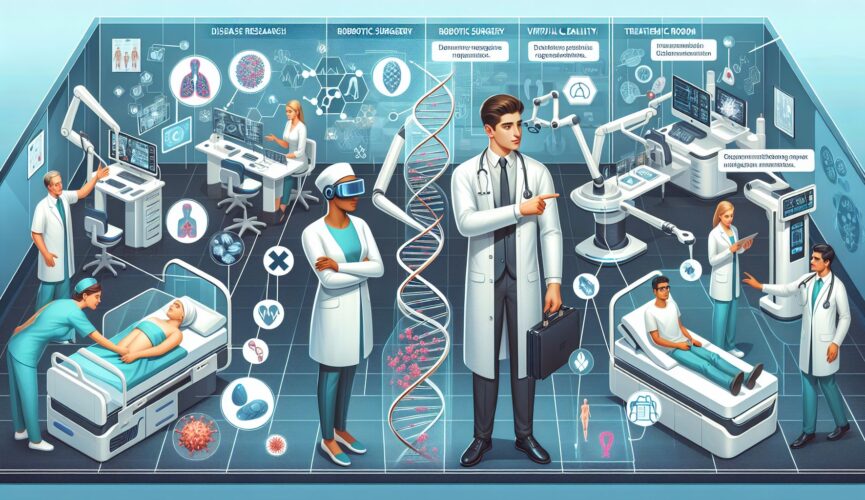In today’s rapidly advancing world, medical technologies have revolutionized the healthcare industry, saving countless lives and improving patient outcomes. From diagnostic tools to innovative treatments, these technologies have become vital assets in understanding diseases and preventing their progression. In this article, we will explore some of the most remarkable medical technologies that are making a significant impact on disease prevention and management.
Introduction
Diseases, both chronic and acute, have long been a challenge for humanity. Understanding the mechanisms behind diseases and finding effective ways to prevent and treat them has been a top priority for healthcare professionals. The advent of medical technologies has provided immense opportunities to accurately diagnose diseases earlier, provide individualized treatment plans, and ultimately save lives. Let us delve into some of these lifesaving technologies and their impact on disease prevention.
Body
1. Genetic Testing
Genetic testing has emerged as a powerful tool in identifying individuals with a higher predisposition to inheritable diseases. By analyzing an individual’s DNA, these tests can detect alterations in specific genes associated with inherited conditions such as cystic fibrosis, breast cancer, or sickle cell anemia. This knowledge allows individuals to take proactive steps, such as lifestyle modifications or preventive surgeries, to reduce the risk of disease development.
2. Telemedicine
Telemedicine has transformed the way healthcare is delivered, particularly in remote areas with limited access to medical facilities. With the help of telecommunication technologies, healthcare professionals can now provide remote consultation, diagnosis, and even monitor patients’ conditions from a distance. Timely consultations enable patients to receive appropriate treatment promptly, preventing diseases from progressing to critical stages.
3. Wearable Devices
Wearable devices have gained significant popularity in recent years, and their potential application in disease prevention should not be overlooked. These devices, like smartwatches or fitness trackers, can continuously monitor various biological parameters, such as heart rate, blood pressure, or sleep patterns. By tracking vital signs and providing real-time feedback, wearable devices empower individuals to adopt healthier lifestyles, identify early warning signs of potential diseases, and seek medical attention proactively.
4. Artificial Intelligence (AI)
Artificial Intelligence has rapidly become a game-changer in healthcare by assisting in disease diagnosis and prevention. AI algorithms can analyze vast amounts of patient data and identify patterns that might go unnoticed by human clinicians. Machine learning algorithms can predict disease outcomes, detect anomalies in medical images, and help develop personalized treatment plans. Incorporating AI into medical technologies allows for more accurate and timely diagnosis, ultimately improving patient outcomes.
5. Robotic Assisted Surgery
Robotics-assisted surgery has brought unmatched precision and efficiency to the operating room. Surgeons can now perform complex procedures using robotic systems, which offer enhanced dexterity and visualization. These technologies enable minimally invasive procedures, resulting in reduced patient trauma, faster recovery times, and decreased risk of complications. Robotic-assisted surgery also allows surgeons to access hard-to-reach areas with greater precision, expanding the possibilities for disease eradication.
6. Nanotechnology
Nanotechnology, as an interdisciplinary field, offers immense potential in combating various diseases. Through the precise manipulation of materials at the nanoscale level, novel treatments and diagnostics can be developed. Nanotechnology-based drug delivery systems, for instance, increase the targeted delivery of medications to affected tissues, minimizing side effects on healthy cells. Additionally, nanoparticle-based diagnostic tools can detect diseases at an early stage, enabling prompt intervention and timely treatment.
Conclusion
Medical technologies have undoubtedly transformed the landscape of disease prevention and management. From genetic testing to robotic-assisted surgeries, each innovation provides unique opportunities to save lives, improve patient outcomes, and prevent disease progression. As science and technology continue to advance, the synergy between healthcare and technology holds tremendous potential for enhancing disease prevention measures. By embracing these lifesaving techniques and introducing advancements, medical professionals are changing the face of healthcare, providing hope for a healthier and disease-free future.
Remember, understanding diseases and preventing their progression is a collective effort that involves healthcare providers, technology developers, and individuals. By staying informed about the latest medical technologies and actively participating in disease prevention, we can all play a role in ensuring a healthier and brighter tomorrow.
